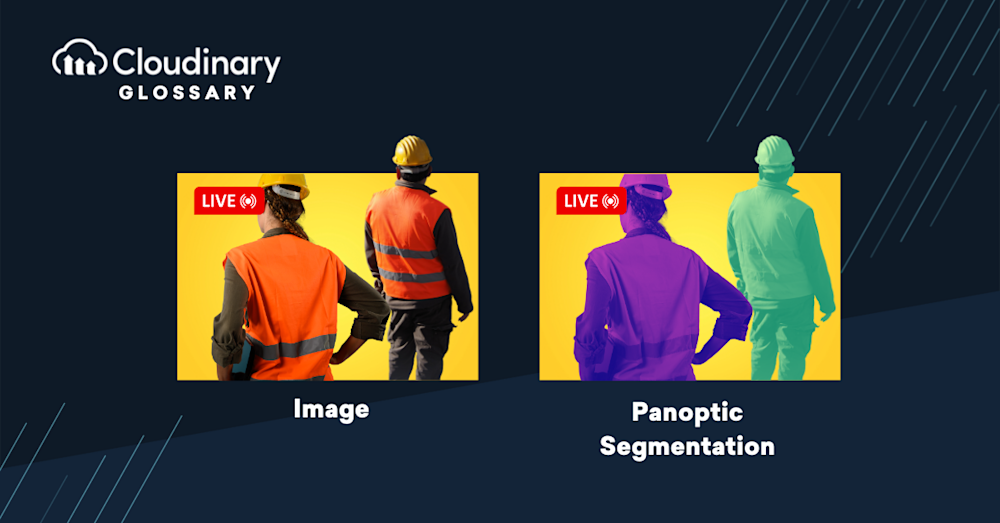What Is Panoptic Segmentation?
Panoptic Segmentation is an approach in computer vision that aims to understand the visual scene in an image or video. It’s about giving a pixel-wise categorization, where every pixel is assigned a label – either as part of a certain object (“thing”) or background scenery (“stuff”).
In simpler terms, it combines two fundamental tasks of scene understanding in computer vision: semantic segmentation, or understanding the scene by classifying individual pixels into distinct categories, and instance segmentation, where specific instances of object categories, such as separate cars, people, etc., are located and differentiated.
The value offered by Panoptic Segmentation lies in versatility and the potential for greater context awareness. Instead of seeing the visual aspects of an image in isolation, they’re viewed as interconnected parts of a whole. For example, understanding that a picture doesn’t just have a “tree” and a “car” but knowing the car is behind the tree adds an additional layer of detail. Moreover, this comprehension proves incredibly useful in numerous practical applications, from autonomous vehicles understanding their surroundings to improved object interaction in augmented reality experiences.
Semantic vs. Instance Segmentation
While both Semantic and Instance Segmentation are crucial components of computer vision, they each address different challenges and provide distinct types of information. Semantic Segmentation focuses on understanding an image at the pixel level, assigning each pixel in the image a label corresponding to its category, such as ‘dog’, ‘car’, or ‘tree’. However, Semantic Segmentation does not distinguish between separate objects of the same category. For example, if multiple cars exist in an image, Semantic Segmentation would not differentiate between them, treating them as one entity.
On the other hand, Instance Segmentation, an advancement of Semantic Segmentation, not only assigns each pixel a category label but also differentiates individual objects within the same category. This means that if there are three cars in an image, Instance Segmentation enables us to identify and isolate each one. Besides categorizing, it gives us the benefit of counting and tracking objects across frames in a video.
While both methods have their unique strengths, the limitations of each are addressed by Panoptic Segmentation, combining the best of both worlds—contextual understanding from Semantic Segmentation and individual object recognition from Instance Segmentation.
How Does Panoptic Segmentation Work?
Panoptic Segmentation operates in a series of stages to comprehensively analyze and categorize an image. Here are the basic steps:
- Pre-processing: The image undergoes an initial pre-processing phase and is converted into a format suitable for further operations such as resizing and normalizing.
- Semantic Segmentation: The processed image is then subjected to semantic segmentation, which labels every pixel according to its category, providing context and general scene understanding.
- Instance Segmentation: Simultaneously, instance segmentation occurs, differentiating between individual objects within the same category and assigning unique identifiers to these instances.
- Pixels Assignment: The outputs from semantic and instance segmentation are then combined, with each pixel ultimately assigned a unique label that identifies its category and the instance to which it belongs.
- Post-processing: Finally, in the post-processing stage, the results are combined to create the final, panoptical-segmented image. The output is an image where every pixel has been precisely categorized and contextualized within the scene.
Common Use Cases for Panoptic Segmentation
Panoptic Segmentation has proven to be a versatile tool in computer vision, expanding the horizon for a range of applications and industries where detailed visual understanding is critical:
- Autonomous Vehicles – To safely navigate, autonomous vehicles require a thorough understanding of their surroundings. Panoptic Segmentation helps identify and differentiate between objects and background elements, such as pedestrians, other vehicles, and road signs.
- Augmented Reality (AR) and Virtual Reality (VR) – Panoptic Segmentation supports more immersive and interactive AR and VR experiences by accurately identifying and classifying every pixel of a visual scene.
- Medical Imaging – In healthcare, Panoptic Segmentation can help identify different tissues, cells, and structures in medical images, aiding diagnosis and treatment planning.
- Surveillance Systems – Enhanced scene understanding can improve object tracking and anomaly detection in video surveillance, contributing to better security outcomes.
- Robotics – Recognizing and distinguishing between objects and spaces is crucial for robots interacting with their environment. This tech helps robots to interact appropriately with various objects and navigate complex environments.
Wrapping Up
Panoptic segmentation is a linchpin for computer vision tasks, melding the best semantic and instance segmentation aspects to deliver comprehensive scene understanding at a pixel level. It’s an exciting field already proving transformative across various applications, from autonomous vehicles to AR/VR, healthcare, surveillance, and robotics. Users can interact with more nuanced, detailed, and contextualized visual data representation, facilitating more accurate and richer outcomes.
Ready to harness the power of Panoptic Segmentation? Cloudinary’s innovative technology stack, equipped with cutting-edge AI capabilities, is designed to empower you to handle intricate image and video manipulation tasks. Get started with Cloudinary today and take the next step in leveraging deep visual insights for your projects, using the capacity of Panoptic Segmentation to its fullest potential.
From simplifying operations to driving innovation in your business, the time to explore the possibilities with Cloudinary is now.
Additional Resources You May Find Useful:



